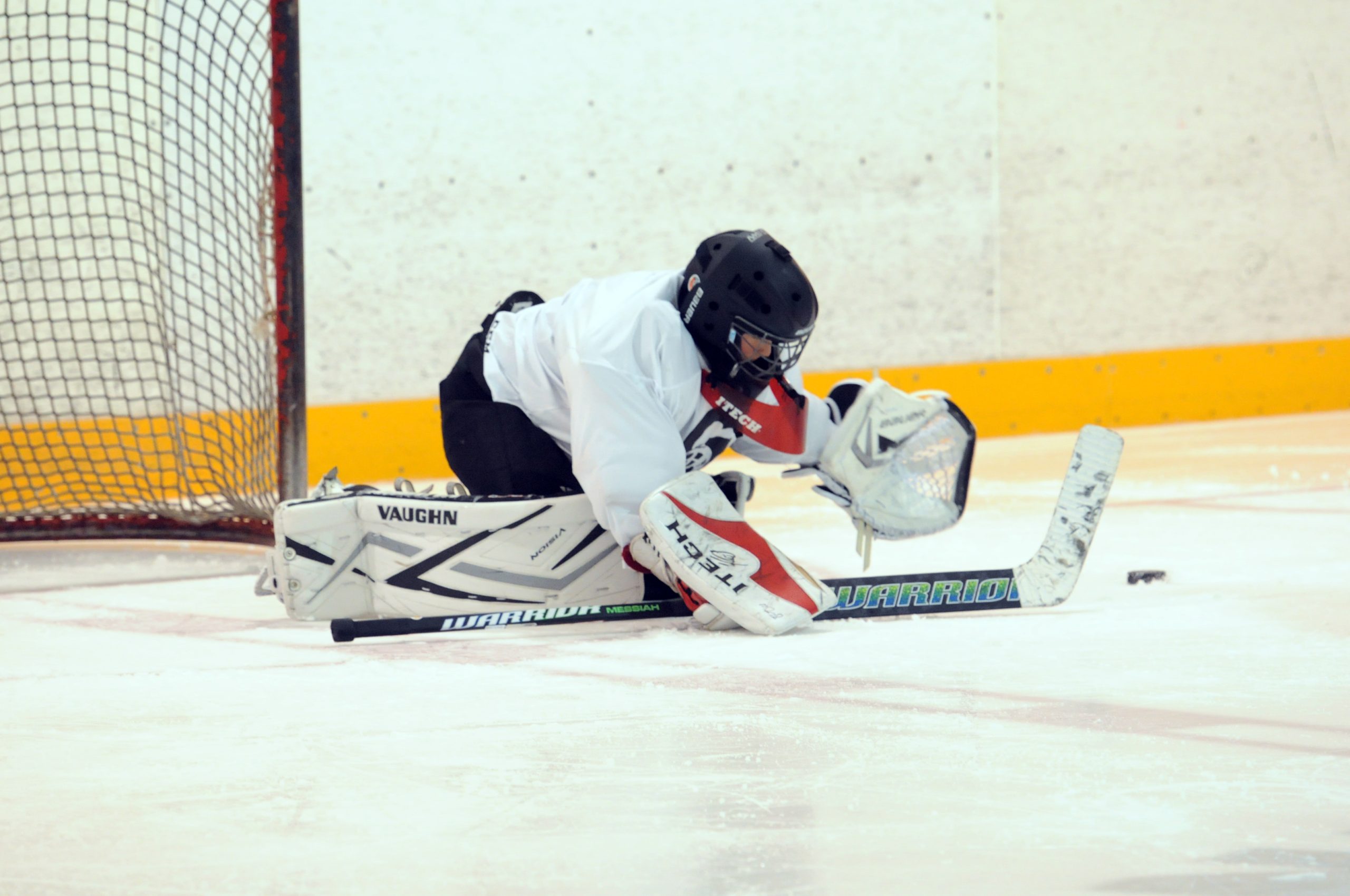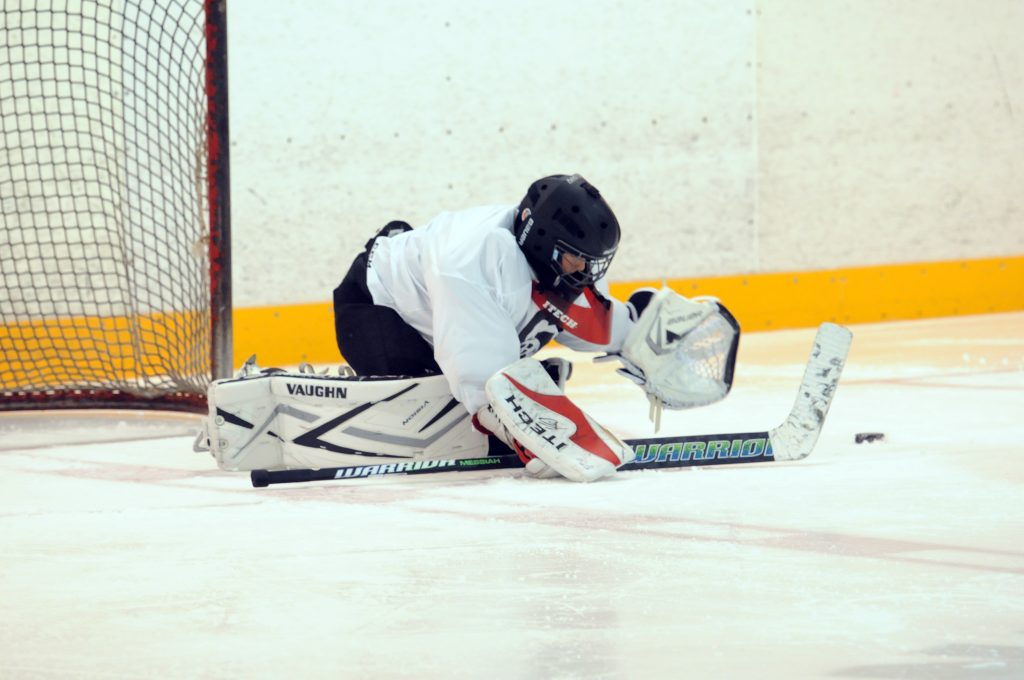
Freezing Pucks
In competitive hockey, there’s a lot of talk about sacrifice. And for anyone who has had the privilege to play hockey at the competitive level, the frequent term of the need to sacrifice the body to make the play doesn’t seem too much to ask.
Goalies however, can learn to make the necessary plays to further their team’s success without maximizing the risk of injury (for the most part). No matter which level a goaltender decides to play at, they will experience a spear, slash or pileup. But in order to minimize the risk of injury, Goalie Army Academy teaches our students that when freezing pucks, they must do so efficiently and protect the puck from the opposition. This allows them to enable themselves to protect against injury in the process.
 Ask any coach ranging from “goaltender expert” to “clueless about goalies”, and they’ll tell you that one of the most difficult things for them to watch in a game is when their goaltender is freezing pucks by attempting to get their glove on top of it while it’s still moving, and before stopping it with their hockey stick. It is imperative for goaltenders to ensure that they stop, and control the puck in order to make the freezing process easier to handle.
Ask any coach ranging from “goaltender expert” to “clueless about goalies”, and they’ll tell you that one of the most difficult things for them to watch in a game is when their goaltender is freezing pucks by attempting to get their glove on top of it while it’s still moving, and before stopping it with their hockey stick. It is imperative for goaltenders to ensure that they stop, and control the puck in order to make the freezing process easier to handle.
Whether the puck is merely being dumped into the defensive zone with little to no pressure on the goaltender, or there are 2 opposing players which are fractions of seconds from tapping the puck into the net, all goaltenders should ensure that they apply the following when they are freezing pucks:
Control the Puck
Let’s face it, stopping the puck with your stick before putting your glove on it is just common sense. Doing so will allow goaltenders to either freeze it, or after looking around and evaluating the play, goaltenders may even be able to play the puck to one of their teammates. If you don’t stop the puck before trying to get your glove on it, you’re just asking for trouble.
Cover the Bottom of the Net
Just like you would cover the bottom portion of the net for a close-proximity shot, goaltenders should cover the bottom of the net when freezing pucks. This allows the goaltender to maintain a wall between the puck and the goal line with their legs in case they have failed to apply proper control of the puck, or in case the puck gets poked out from under their glove. Placing the legs in this position allows the goaltender a 2nd attempt at stopping and freezing the puck if by chance it does happen to get poked free.
Place Glove on Puck
After applying a proper stop and control of the puck and drop down to the knees, goaltenders should be quick and aggressive when freezing pucks in front of them. So get that glove out there quickly.
Protect the Puck
Protecting the puck, and your glove hand properly is never a bad idea. By placing the paddle of the goaltender’s hockey stick in front of their glove, goaltenders are able to protect themselves against potential spears and slashes to their glove hand. Placing the paddle of the stick this way also enables the goaltender to protect the puck under their glove from the opposition trying to whack it loose from the goaltender’s possession.
The goaltender should always be aware of their surroundings in order to determine which directions may pose threats to the puck remaining frozen or to their health and safety. Adjusting the position of the paddle of their stick in order to slide it between the glove and the opposition’s threats is an additional bonus to stopping and freezing pucks.
The Don’t Do’s
At Goalie Army Academy, we place a lot of emphasis on teaching our students what we feel would be the most efficient way of doing things to help them become the best goaltenders that they can be. We also believe that there is no wrong way to stop a puck and feel that being an efficient goaltender is key to any goaltender who is looking to take his or her game to the next level. We will rarely say to our students that they shouldn’t do certain things as we feel strongly that there isn’t just one technical method. However, we do suggest not doing the following:
- Freezing pucks with one knee down
- Protecting the puck with only the blade of your stick
- Opening the knees
The above points have been listed in order to help students avoid letting in goals which could have been prevented, as well as to help them avoid injury.
Freezing Pucks With One Knee Down
By implementing this technique, goaltenders become more susceptible to injury as well as become easier targets to be knocked off of the puck. In scramble circumstances, goalies may implement this technique initially, but it is recommended that upon getting the glove on top of the puck, that the goaltender transitions to having both of their knees down on the ice. This will allow them to recover quickly in any direction if the puck happens to get knocked loose, protect the puck more effectively with the whole paddle of the stick rather than the just the blade, as well as aid in avoiding groin, hip, and knee injuries when the opposition crashes the net.
Protecting the Puck With Only the Blade of Your Stick
It’s fair to say that when freezing the puck, the goaltender has already made up his or her mind about not giving it back until after the whistle. However, some goalies still apply a method of freezing pucks which allows them to cover it with their glove and protect it with only the blade of their stick.
By protecting the glove with the blade of the stick only, the goaltender is more susceptible to allowing the puck to be poked free as his blocker hand is holding the stick at a higher level which allows for the his stick to be knocked and therefore moved by the opposition. Without the stick in front of the glove hand, the goaltender becomes more open to injury, or losing control of the puck.
Instead, the goaltender should lay the paddle of his stick on its edge in front of his glove in order to protect himself as well as protect the puck more effectively. This position will also allow the goaltender to move his paddle between his glove and the blades of the sticks of the opposition if he anticipates pokes or whacks at the puck while he has it in his possession.
Opening the Knees
Some goaltenders will open their knees after freezing the puck thinking that this allows them to gain more balance when being charged at by the opposition. The reality is that by focusing more attention on adding weight distribution to the top part of the body, mainly the shoulders and arms, the goaltender makes themselves harder to move off of the puck. However, by spreading the knees open more, the goaltender increases their risk of injury to their lower body if someone lands on them due to additional strain on their groin.
As we mentioned within the article above, GAAHockey feels that there is no wrong way of stopping a puck, but that there is a better way to become more technically efficient. By becoming technically efficient, goaltenders learn to process options and responses to game situations more quickly, which generally results in more saves and wins. For more tips and technical information feel free to check out other articles within our blog, or contact us directly so that we may answer any questions or concerns about the information above. We’re always happy to hear from you.
Want to Train With Us to learn more about becoming an effective and efficient goaltender? Check out our Program Options and Enlist Now!


Leave a Reply